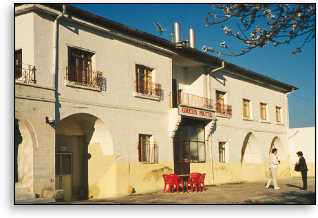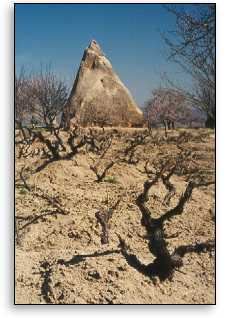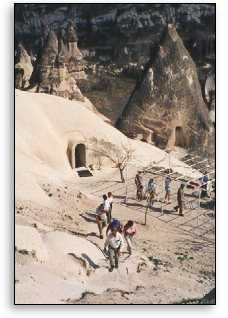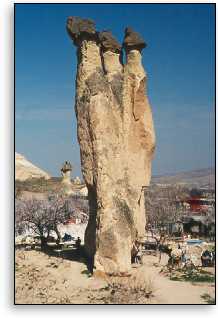Cappadocia,
Zelve,
Goreme,
Avanos
Western Turkey - Group Journal
Day 5 -
Wednesday, 8 April 1998
by Jim and Becky Drahovzal
 After a cold night for many in the Green
Motel, we arose to a mild, sunny, windless morning. What a surprise to discover
a view of the light tan volcanic tuff forming conical peaks with doorways and
windows carved carefully into the rock. It was better than any of the pictures
we had previously seen of this beautiful land called Cappadocia. The apricot
blossoms, the rich blue sky and the buff-colored rocks demanded an early
morning picture.
After a cold night for many in the Green
Motel, we arose to a mild, sunny, windless morning. What a surprise to discover
a view of the light tan volcanic tuff forming conical peaks with doorways and
windows carved carefully into the rock. It was better than any of the pictures
we had previously seen of this beautiful land called Cappadocia. The apricot
blossoms, the rich blue sky and the buff-colored rocks demanded an early
morning picture.
Breakfast was served in the dining room of the motel at 7:30, after the bread arrived by truck. The walls of the breakfast room were covered with carpets and other treasures of the kind and attentive owners. We had what we had all become accustomed to as a typical breakfast in Turkey - boiled eggs, tomatoes, cucumbers, olives, bread, cheese, butter and Turkish tea - much more than most of us are used to. The bread was stacked in a fashion similar to the Cappadocian fairy chimneys that characterize the area. A sweet spread for the bread was identified as sorghum, molasses and honey, but in reality was boiled raisins.
Several of us took a walk after breakfast to have a closer view of the fantastic rock formations. We were greeted by a woman in Turkish dress who invited us into her house.
Tom and Pat came along a couple of minutes later and our hostess showed us her house which was partially carved into a hill. The furnishings were simple, but they had a gas stove and a washing machine. Two little girls were asleep in the bed when she opened the door to their room. She took us to a back store-room and showed us her handicrafts. We left with a doll to take home and some colorful, knitted oversized socks to wear to bed tonight! Our hostess had henna on her hands to celebrate Bayram, and we saw blood stains near a floor drain, probably from the sacrifice yesterday.
In the bus, Meli told us about the "two mothers of Cappadocia" - volcanoes whose ash spread out to form the landscape. She emphasized that it was not only the form of the land, but the people who make this area unique.
 We walked up on a high bluff for a good
view of the landscape. The weather was perfect with a clear blue sky. We walked
on paths that wound between apricot trees full of pale pink blossoms,
surrounded by grapevines, most of them freshly pruned with soil mounded up
around them.
We walked up on a high bluff for a good
view of the landscape. The weather was perfect with a clear blue sky. We walked
on paths that wound between apricot trees full of pale pink blossoms,
surrounded by grapevines, most of them freshly pruned with soil mounded up
around them.
We went on to the Zelve Open Air Museum which has been built in 3 valleys, occupied by a maximum of 1200 people. It was evacuated in 1952. The government had built square cement buildings for the community, but they resisted moving for 6 years.
In over 2000 years they had adjusted to the inconvenience of climbing steep steps and ladders, and the rooms in the rocks provided shelter that was cool in the summer. Also the "geotecture" (Meli's word!) was beautiful.
We sat in a mill and heard about the pigeon roosts which were painted to attract the pigeons so their droppings could be used for fertilizer for the grapes. The walls of the mill room were carved out around the millstone to accommodate the bellies of the donkeys who pulled the millstone.
Next we visited the Fish Church and the Grape Church where we discussed the Christian symbols and their significance.
We went into a one room house with carved out u-shaped benches, 4 niches used as cupboards and a fireplace. Pruned vine branches were used for fuel, supplemented with dung. The window had holes beside it to hold bars so the window could be used for a "playpen" for the baby.
We went back to the Green Hotel for lunch. Tables were set up outside and we had a delicious homemade meal under sunny skies; lentil soup (recipe follows), tin kebap - (a special meat dish cooked in a metal pan), bulgar pilaf, yogurt (made from milk from their cow that was wandering among the grapevines in a nearby field as we ate), apples & oranges for dessert.

Meli took us to the home of some people who carved the rooms out of the rock they own. It had formerly been the grandfather's pigeon house. Traditional u-shaped benches lining the walls were covered with carpets and kilims. A dowry carpet hung on the wall. A cupboard was covered with a carpet hanging on the wall. After being served tea, we saw a beautiful bedroom with a lovely plant area and a large window overlooking the Cappadocian landscape. They also have two other floors in their house. They are connected to city water, sewer, electricity and gas.
Next we went to the Goreme museum. Meli explained that Cappadocia is important because it was on a major trade route. Paul came to Kayseri, so there was a Christian community here very early. During both the Roman and Muslim persecutions, Christians used Cappadocia as a refuge. Monasteries were here from the 4th century when monks taught by means of pictures, so the rooms were decorated with many frescoes of the life of Jesus and early saints. We visited the following churches and chapels: Carikli Church, Yilonli Church, Chapel of St. Barbara, and the Apple Church.
Our final stop was the carpet cooperative in Avanos. A guide talked about the unique double knot used in Turkish carpets and we saw several young women working on carpets. 643 double knots per square inch are optimal for a carpet to be used on the floor.
We saw a demonstration of the way the cocoons of the silk worms are heated in hot water until the worm dies; then the threads are extracted and spun.
In the next room we saw vats of dye and a man demonstrated the dying process. He showed us how indigo dyes the yarn green, then after about 15 seconds it becomes blue because of oxidation.
In the carpet show room, before the carpets were brought out, we were all given a choice of Turkish tea, apple tea, Turkish coffee, wine or raki. (A licorice flavored drink with a mean kick.)
After the carpets were shown, some went back to the Green Hotel and others stayed to buy carpets.
Dinner in the evening was at the elegant Ottoman House, where we had carrot soup, meze, "high society mante," and a sweet dessert of cake soaked in syrup.
When we returned in the evening our laundry was ready for us. All we had to do was to identify it!
Cappadocian lentil soup from the Green Hotel
1 pound red lentils - washed and soaked. Sauté in butter or margarine: 3-4 peeled and chopped tomatoes Add 1 tbsp. dried mint Salt and pepper Add lentils Cook until soft. Another lentil soup recipe from Meli Wash and soak 1 lb. red lentils add 1 red onion cut in quarters 2 yellow potatoes cut into cubes Cook together and puree in blender.
A geologic appendix:
Much of what Turkey is today, geologically, is the result of the collision of two great continental plates - the Eurasian and Afro-Arabian plates - that collided beginning some 50-60 million years ago along an east-west zone. The zone is part of a much larger zone extending from Spain to China. The collision resulted in two major orogenic (mountain) belts: the Taurides in the south and the Pontides in the north that bound the central Anatolide platform. The central Anatolide platform is characterized by 20 million years old to recent volcanic rocks. Since about 12 million years ago the main part of Turkey has been moving westward as the result of an action similar to a watermelon seed being squeezed by a giant thumb and forefinger (the thumb and forefinger where the squeeze is taking place is in eastern Turkey where the two plates are colliding).
Far western Turkey, as well as parts of central Turkey, away from the squeeze of the east, are actually expanding in a north-south direction. This tension produces giant tears in the crust, resulting in rift basins that fill with volcanic rocks from below and sediments from the surrounding land. All of these processes result in mountain building, faulting, volcanism, basin formation and earthquake activity - all of which continue to take place up to the present day. Geologically, Turkey is very active and dynamic and these geologic processes often result in the destruction of human life and property (probably not a good place for the construction of the used Soviet nuclear power plants that Meli mentioned).

The volcanic activity in the Cappadocian area that we visited goes back about 10 million years. What we see is the result of the collision tectonics and the extension that is occurring in the area. The volcanoes erupted, filling sedimentary basins in at least 9 major eruptions between 10 and 3 million years ago. In a second series of major eruptions between 150,000 and 70,00 years ago, both Erciyes Dag (3916m) and Hasan Dag (3253m) spread volcanic tuff* across the region. This is the material that makes the fairy chimneys that we have enjoyed looking at and the same material that has been carved into animal shelters, homes, churches and underground cities.
Volcanic tuff is pyroclastic rock (literally from the Greek: fire fragment). It represents ash-fall material. Sometimes it exhibits rock crystals that grow in place as the ash cools from the molten state. As Meli said the two volcanoes Erciyes Dag and Hasan Dag are the mothers of the volcanic tuff. Both of these volcanoes are the classic strato volcano style with their concave flanks. Erciyes Dag is the one we caught a glimpse of on our way to Avanos and the Green Motel. For the next two days we were lucky enough to see it in its full snow-covered glory. This volcano last erupted in the 1st century A.D. Hasan Dag was the volcano that we saw the day later as we approached Aksaray.
*Note: The terms tuff and tufa are often confused in the tourist literature. These are two quite different rock types. Tuff is an igneous rock representing ash-fall material from a volcanic eruption. It is composed of complex silica-rich minerals. Tufa, on the other hand, is a sedimentary rock formed by calcium carbonate secreting algae living in a hot spring. It is often characterized by layering and onion-skin like structures where the calcium carbonate was precipitated chemically or organically.